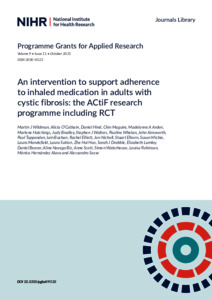WILDMAN, Martin J., O’CATHAIN, Alicia, HIND, Daniel, MAGUIRE, Chin, ARDEN, Madelynne, HUTCHINGS, Marlene, BRADLEY, Judy, WALTERS, Stephen J., WHELAN, Pauline, AINSWORTH, John, TAPPENDEN, Paul, BUCHAN, Iain, ELLIOTT, Rachel, NICHOLL, Jon, ELBORN, Stuart, MICHIE, Susan, MANDEFIELD, Laura, SUTTON, Laura, HOO, Zhe Hui, DRABBLE, Sarah J., LUMLEY, Elizabeth, BEEVER, Daniel, NAVEGA BIZ, Aline, SCOTT, Anne, WATERHOUSE, Simon, ROBINSON, Louisa, HERNÁNDEZ ALAVA, Mónica and SASSO, Alessandro
(2021).
An intervention to support adherence to inhaled medication in adults with cystic fibrosis: the ACtiF research programme including RCT.
Programme Grants for Applied Research, 9 (11), 1-146.
[Article]
Documents
29478:597679
![[thumbnail of Arden-InterventionSupportAdherence(VoR).pdf]](https://shura.shu.ac.uk/29478/1.hassmallThumbnailVersion/Arden-InterventionSupportAdherence%28VoR%29.pdf)

Preview
Abstract
Background
People with cystic fibrosis frequently have low levels of adherence to inhaled medications.
Objectives
The objectives were to develop and evaluate an intervention for adults with cystic fibrosis to improve adherence to their inhaled medication.
Design
We used agile software methods to develop an online platform. We used mixed methods to develop a behaviour change intervention for delivery by an interventionist. These were integrated to become the CFHealthHub intervention. We undertook a feasibility study consisting of a pilot randomised controlled trial and process evaluation in two cystic fibrosis centres. We evaluated the intervention using an open-label, parallel-group randomised controlled trial with usual care as the control. Participants were randomised in a 1 : 1 ratio to intervention or usual care. Usual care consisted of clinic visits every 3 months. We undertook a process evaluation alongside the randomised controlled trial, including a fidelity study, a qualitative interview study and a mediation analysis. We undertook a health economic analysis using both a within-trial and model-based analysis.
Setting
The randomised controlled trial took place in 19 UK cystic fibrosis centres.
Participants
Participants were people aged ≥ 16 years with cystic fibrosis, on the cystic fibrosis registry, not post lung transplant or on the active transplant list, who were able to consent and not using dry-powder inhalers.
Intervention
People with cystic fibrosis used a nebuliser with electronic monitoring capabilities. This transferred data automatically to a digital platform. People with cystic fibrosis and clinicians could monitor adherence using these data, including through a mobile application (app). CFHealthHub displayed graphs of adherence data as well as educational and problem-solving information. A trained interventionist helped people with cystic fibrosis to address their adherence.
Main outcome measures
Randomised controlled trial – adjusted incidence rate ratio of pulmonary exacerbations meeting the modified Fuchs criteria over a 12-month follow-up period (primary outcome); change in percentage adherence; and per cent predicted forced expiratory volume in 1 second (key secondary outcomes). Process evaluation – percentage fidelity to intervention delivery, and participant and interventionist perceptions of the intervention. Economic modelling – incremental cost per quality-adjusted life-year gained.
Results
Randomised controlled trial – 608 participants were randomised to the intervention (n = 305) or usual care (n = 303). To our knowledge, this was the largest randomised controlled trial in cystic fibrosis undertaken in the UK. The adjusted rate of exacerbations per year (primary outcome) was 1.63 in the intervention and 1.77 in the usual-care arm (incidence rate ratio 0.96, 95% confidence interval 0.83 to 1.12; p = 0.638) after adjustment for covariates. The adjusted difference in mean weekly normative adherence was 9.5% (95% confidence interval 8.6% to 10.4%) across 1 year, favouring the intervention. Adjusted mean difference in forced expiratory volume in 1 second (per cent) predicted at 12 months was 1.4% (95% confidence interval –0.2% to 3.0%). No adverse events were related to the intervention. Process evaluation – fidelity of intervention delivery was high, the intervention was acceptable to people with cystic fibrosis, participants engaged with the intervention [287/305 (94%) attended the first intervention visit], expected mechanisms of action were identified and contextual factors varied between randomised controlled trial sites. Qualitative interviews with 22 people with cystic fibrosis and 26 interventionists identified that people with cystic fibrosis welcomed the objective adherence data as proof of actions to self and others, and valued the relationship that they built with the interventionists. Economic modelling – the within-trial analysis suggests that the intervention generated 0.01 additional quality-adjusted life-years at an additional cost of £865.91 per patient, leading to an incremental cost-effectiveness ratio of £71,136 per quality-adjusted life-year gained. This should be interpreted with caution owing to the short time horizon. The health economic model suggests that the intervention is expected to generate 0.17 additional quality-adjusted life-years and cost savings of £1790 over a lifetime (70-year) horizon; hence, the intervention is expected to dominate usual care. Assuming a willingness-to-pay threshold of £20,000 per quality-adjusted life-year gained, the probability that the intervention generates more net benefit than usual care is 0.89. The model results are dependent on assumptions regarding the duration over which costs and effects of the intervention apply, the impact of the intervention on forced expiratory volume in 1 second (per cent) predicted and the relationship between increased adherence and drug-prescribing levels.
Limitations
Number of exacerbations is a sensitive and valid measure of clinical change used in many trials. However, data collection of this outcome in this context was challenging and could have been subject to bias. It was not possible to measure baseline adherence accurately. It was not possible to quantify the impact of the intervention on the number of packs of medicines prescribed.
Conclusions
We developed a feasible and acceptable intervention that was delivered to fidelity in the randomised controlled trial. We observed no statistically significant difference in the primary outcome of exacerbation rates over 12 months. We observed an increase in normative adherence levels in a disease where adherence levels are low. The magnitude of the increase in adherence may not have been large enough to affect exacerbations.
Actions (login required)
 |
View Item |



 Tools
Tools Tools
Tools